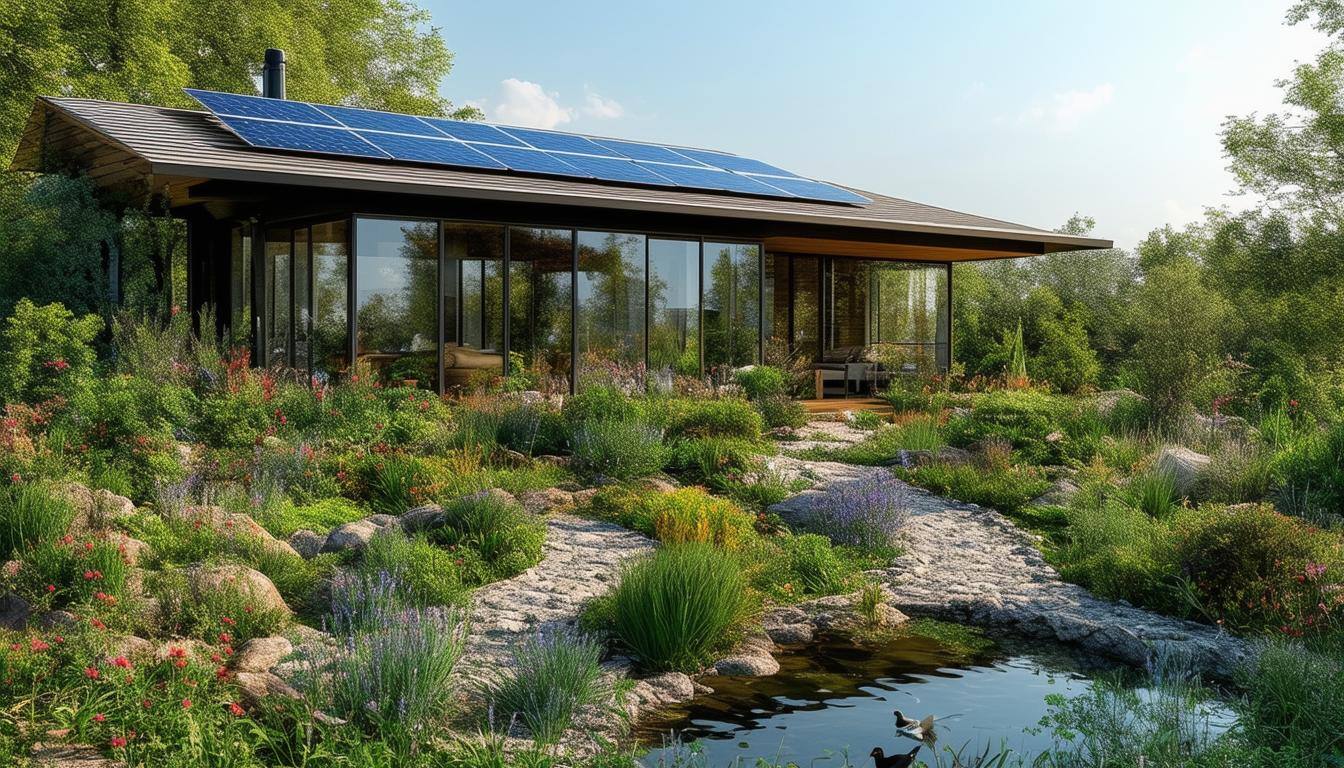Carbon Neutral and Beyond
Introduction
6 min read
Noah Riley
:
Feb 19, 2024 7:46:55 AM

Discover the importance of reducing embodied carbon in new construction homes and how it can contribute to reducing climate change and building a healthier, greener and more sustainable future.
Understanding embodied carbon is crucial in the context of new construction homes. Embodied carbon refers to the carbon dioxide emissions associated with the manufacturing, transportation, and construction of building materials. It is important to consider this aspect as it accounts for a significant portion of a building's carbon footprint.
By understanding embodied carbon, builders and homeowners can make informed decisions to minimize the environmental impact of new homes.
Embodied carbon refers to the amount of carbon dioxide (CO2) and other greenhouse gases (GHGs) emitted during the lifecycle of a material or product. This encompasses all stages, from the extraction of raw materials through manufacturing, transportation, installation, maintenance, and disposal or recycling. In the context of construction and the built environment, embodied carbon is a significant consideration because the materials and processes involved in building construction, renovation, and demolition can contribute substantially to a project's overall carbon footprint.
Embodied carbon is distinct from operational carbon, which refers to the emissions resulting from the use and operation of a building or infrastructure over its lifetime, such as heating, cooling, lighting, and other energy uses. While operational carbon emissions can be reduced over time with improvements in energy efficiency and the use of renewable energy sources, embodied carbon is "locked in" as soon as a building is constructed, making it crucial to address upfront during the design and material selection phases to minimize a project's total carbon impact.
Reducing embodied carbon involves selecting low-carbon materials, optimizing a design to use less material, employing advanced manufacturing techniques, recycling materials, and considering the end-of-life stage of the project to ensure materials can be reused or recycled. It is an integral part of sustainable design and construction practices aimed at achieving net-zero carbon buildings and infrastructure, contributing to broader efforts to mitigate climate change.
The impacts of embodied carbon are significant and wide-ranging, affecting both the environment and society in various ways. By understanding these impacts, it becomes clear why reducing embodied carbon in construction and other industries is crucial for sustainable development and climate change mitigation. Here are some of the key impacts of embodied carbon:
Climate Change Acceleration: The most direct impact of embodied carbon is its contribution to global greenhouse gas emissions, which are the primary drivers of climate change. These emissions contribute to global warming, leading to more extreme weather events, rising sea levels, and other environmental changes that can have devastating effects on ecosystems, human health, and economies.
Resource Depletion: The extraction and processing of raw materials for construction and other industries often require significant energy, much of which comes from fossil fuels. This not only contributes to embodied carbon but also depletes natural resources, leading to potential shortages and loss of biodiversity.
Air and Water Pollution: The processes involved in manufacturing building materials and constructing buildings can lead to the release of pollutants into the air and water, impacting both environmental quality and human health. For example, cement production, a significant contributor to embodied carbon, also releases particulate matter and other pollutants.
Waste Generation: Construction and demolition activities generate vast amounts of waste. While this is more closely related to the life cycle of a building rather than just the embodied carbon, the production of materials that are not efficiently used or that are destined for short-term use before disposal contributes to this problem.
Economic Costs: The impacts of climate change, including more frequent and severe natural disasters, can have significant economic costs in terms of damage to infrastructure, increased insurance premiums, and the need for adaptation measures. Reducing embodied carbon can help mitigate these costs by contributing to the stabilization of the climate.
Social and Health Impacts: Communities, particularly those in vulnerable regions, face direct health and social impacts from climate change and pollution. For example, air pollution can lead to respiratory and cardiovascular diseases, while climate change can exacerbate food and water scarcity, leading to displacement and conflict.
Barrier to Achieving Climate Goals: High levels of embodied carbon in the built environment and other sectors pose a significant barrier to meeting international climate targets, such as those set out in the Paris Agreement. Reducing embodied carbon is essential for limiting global warming to well below 2 degrees Celsius above pre-industrial levels.
Addressing the impacts of embodied carbon requires concerted efforts across industries, government policies, and individual actions. Strategies such as using low-carbon materials, improving efficiency in design and construction, and adopting circular economy principles can help reduce the embodied carbon footprint of new construction and contribute to more sustainable and resilient communities.
Reducing embodied carbon in construction involves a combination of strategies aimed at minimizing the carbon footprint associated with the materials and processes from extraction through to end-of-life. Here are some effective strategies for reducing embodied carbon:
Material Selection:
Design Optimization:
Construction Techniques:
Supply Chain Management:
End-of-Life Considerations:
Innovation and Technology:
Policy and Standards:
Renewable Energy Use:
By integrating these strategies into construction projects, the industry can significantly reduce the embodied carbon of new buildings and infrastructure, contributing to global efforts to combat climate change.
Eco-friendly homes, designed with sustainability and environmental considerations at their core, offer numerous benefits not only to homeowners but also to the surrounding environment. These benefits stem from reduced energy consumption, minimized environmental impact, and a healthier living space.
Here's an overview of the key benefits:
Reduced Energy Bills: Eco-friendly homes are often equipped with energy-efficient appliances, insulation, and sometimes renewable energy sources like solar panels. This leads to significant savings on utility bills over time.
Increased Property Value: Homes with eco-friendly features can have a higher market value. Buyers are increasingly aware of the benefits of sustainable homes, making them more attractive in the real estate market.
Healthier Living Environment: Sustainable homes often use non-toxic materials and improve indoor air quality, leading to a healthier living environment. This can reduce the risk of respiratory diseases, allergies, and other health issues.
Comfort: Eco-friendly homes are designed to maximize natural light and ensure proper ventilation. This, along with superior insulation, enhances the comfort of the living space throughout the year.
Reduced Maintenance and Operation Costs: Sustainable materials and technologies tend to be more durable and require less maintenance over time, saving homeowners money and effort in the long run.
Tax Incentives and Rebates: In many regions, homeowners may benefit from tax incentives, rebates, or grants for incorporating sustainable features into their homes, such as solar panels or energy-efficient appliances.
Lower Carbon Footprint: By using renewable energy sources and energy-efficient designs, eco-friendly homes contribute to a significant reduction in carbon emissions, combating climate change.
Conservation of Resources: Sustainable homes often use materials that are recycled, rapidly renewable, or sustainably sourced, reducing the demand on finite natural resources and minimizing environmental degradation.
Reduced Waste: Eco-friendly construction practices aim to minimize waste and promote recycling and reuse of materials, leading to less landfill waste and lower pollution.
Biodiversity Protection: Sustainable home designs can include considerations for preserving local flora and fauna, contributing to the protection of biodiversity in the area.
Water Efficiency: Features like rainwater harvesting systems, low-flow fixtures, and drought-resistant landscaping reduce water usage, helping to conserve this precious resource.
Promoting Sustainable Communities: Eco-friendly homes can serve as models for sustainable living, encouraging broader community initiatives towards sustainability and environmental stewardship.
In essence, eco-friendly homes create a win-win situation, offering tangible benefits to homeowners through cost savings and improved health, while also contributing to the broader goal of environmental conservation and sustainability.
The future of sustainable construction is promising, with a growing emphasis on reducing embodied carbon and embracing eco-friendly building practices. Innovations in materials, technology, and design are paving the way for more sustainable and energy-efficient homes.
As awareness of climate change increases, the construction industry is moving towards greener practices to create a more sustainable built environment for future generations.
Reimagine what’s possible. At The Unwind, we explore the art of creating healthier, more sustainable homes and communities that inspire a fulfilling and balanced life for generations to come.

When I step into my home or workplace, I expect it to be a safe haven—a space that supports my health and well-being. But I’ve come to realize that...

1 min read
What’s happening: Thousands of homes were destroyed in January’s devastating wildfires. Mayor Bass’s executive order aims to speed rebuilding by...